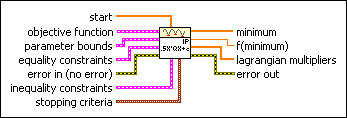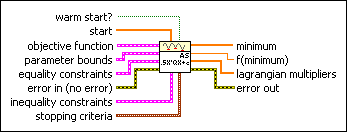 |
start is a point in n dimension at which the optimization process starts.
|
 |
objective function contains the coefficients of the quadratic and linear terms of the formula you want to minimize.
 |
Q is the quadratic term, in the form of a matrix, of the objective function.
|
 |
c is the linear term, in the form of a vector, of the objective function.
|
|
 |
parameter bounds contains the minimum and maximum values the parameters (x) can take.
 |
xmin is the minimum value the parameters can accept.
|
 |
xmax is the maximum value the parameters can accept.
|
|
 |
equality constraints defines the linear matrix equality constraint Ax=b.
 |
A is the matrix term of the linear equality constraint equation.
|
 |
b is the vector term of the linear equality constraint equation.
|
|
 |
error in describes error conditions that occur before this node runs. This input provides standard error in functionality.
|
 |
inequality constraints contains the linear matrix inequality bounds Imin<Dx<Imax.
 |
D is the matrix term of the linear inequality constraint expression.
|
 |
Imin is the minimum value that the linear inequality constraint expression can accept.
|
 |
Imax is the maximum value that the linear inequality constraint expression can accept.
|
|
 |
stopping criteria is the collection of conditions that terminate the optimization. If (function tolerance AND parameter tolerance AND gradient tolerance) OR max iterations OR max function calls then optimization terminates.
 |
function tolerance is the relative change in function value and is defined as abs(current f – prev f)/(abs(curr f)+machine eps). If the relative change in the function value falls below function tolerance, the optimization terminates.
|
 |
parameter tolerance is the relative change in parameter values and is defined as abs(current p – prev p)/(abs(curr p)+machine eps). If the relative change of all the parameter values falls below parameters tolerance, the optimization terminates.
|
 |
gradient tolerance is the 2–norm of the gradient. If the 2–norm of the gradient falls below gradient tolerance, the optimization terminates.
|
 |
max iterations is the largest number of iterations of the major loop of the optimization. If the number of major loop iterations exceeds max iterations, the optimization terminates.
|
 |
max function calls is the largest number of objective function calls allowed before terminating the optimization process.
|
 |
max time (sec) is the maximum amount of time LabVIEW allows between the start and the end of the optimization process. The default is –1. –1 indicates never to time out.
|
|
 |
minimum is the set of values that minimizes the quadratic objective function while satisfying the bounds and constraints.
|
 |
f(minimum) is the value of the quadratic objective function 0.5x^TQx + cx at minimum.
|
 |
lagrangian multipliers are the coefficients of the lagrangian function that corresponds to the equality and inequality constraints. If there are three equality constraints and two inequality constraints, the first three Lagrangian multipliers correspond to the equality constraints, and the last two Lagrangian multipliers correspond to the inequality constraints.
|
 |
error out contains error information. This output provides standard error out functionality.
|
 |
warm start? indicates whether to allow a warm start of the optimization. When warm start? is TRUE, LabVIEW uses the indexes of the active constraints from the previous solution as the initial set of active constraints for the current problem. The default is FALSE.
|
 |
start is a point in n dimension at which the optimization process starts.
|
 |
objective function contains the coefficients of the quadratic and linear terms of the formula you want to minimize.
 |
Q is the quadratic term, in the form of a matrix, of the objective function.
|
 |
c is the linear term, in the form of a vector, of the objective function.
|
|
 |
parameter bounds contains the minimum and maximum values the parameters (x) can take.
 |
xmin is the minimum value the parameters can accept.
|
 |
xmax is the maximum value the parameters can accept.
|
|
 |
equality constraints defines the linear matrix equality constraint Ax=b.
 |
A is the matrix term of the linear equality constraint equation.
|
 |
b is the vector term of the linear equality constraint equation.
|
|
 |
error in describes error conditions that occur before this node runs. This input provides standard error in functionality.
|
 |
inequality constraints contains the linear matrix inequality bounds Imin<Dx<Imax.
 |
D is the matrix term of the linear inequality constraint expression.
|
 |
Imin is the minimum value that the linear inequality constraint expression can accept.
|
 |
Imax is the maximum value that the linear inequality constraint expression can accept.
|
|
 |
stopping criteria is the collection of conditions that terminate the optimization. If (function tolerance AND parameter tolerance AND gradient tolerance) OR max iterations OR max function calls then optimization terminates.
 |
function tolerance is the relative change in function value and is defined as abs(current f – prev f)/(abs(curr f)+machine eps). If the relative change in the function value falls below function tolerance, the optimization terminates.
|
 |
parameter tolerance is the relative change in parameter values and is defined as abs(current p – prev p)/(abs(curr p)+machine eps). If the relative change of all the parameter values falls below parameters tolerance, the optimization terminates.
|
 |
gradient tolerance is the 2–norm of the gradient. If the 2–norm of the gradient falls below gradient tolerance, the optimization terminates.
|
 |
max iterations is the largest number of iterations of the major loop of the optimization. If the number of major loop iterations exceeds max iterations, the optimization terminates.
|
 |
max function calls is the largest number of objective function calls allowed before terminating the optimization process.
|
 |
max time (sec) is the maximum amount of time LabVIEW allows between the start and the end of the optimization process. The default is –1. –1 indicates never to time out.
|
|
 |
minimum is the set of values that minimizes the quadratic objective function while satisfying the bounds and constraints.
|
 |
f(minimum) is the value of the quadratic objective function 0.5x^TQx + cx at minimum.
|
 |
lagrangian multipliers are the coefficients of the lagrangian function that corresponds to the equality and inequality constraints. If there are three equality constraints and two inequality constraints, the first three Lagrangian multipliers correspond to the equality constraints, and the last two Lagrangian multipliers correspond to the inequality constraints.
|
 |
error out contains error information. This output provides standard error out functionality.
|
 Add to the block diagram
Add to the block diagram Find on the palette
Find on the palette











